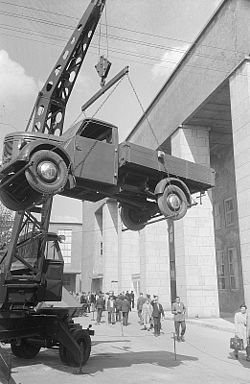Framo V 901
| Framo / Barkas | |
|---|---|
|
V 901 flatbed truck at the Leipzig trade fair in 1953.
|
|
| V 901 | |
| Manufacturer: | Framo (IFA) |
| Production period: | 1951-1954 |
| Previous model: | Framo V 501 |
| Successor: | Barkas V 901/2 |
| Technical specifications | |
| Designs: | Flatbed , box van , minibus , ambulance |
| Engines: |
Otto engine : 0.9 liters (18 kW) |
| Payload: | up to 0.75 t |
| Perm. Total weight: | 1.7 t |
The Framo V 901 is a pickup truck that was manufactured by Framo in Hainichen between 1951 and 1954 . As a three-quarter- tonner, it was the smallest truck in what was then the GDR vehicle construction and was located below the granite phenomenon .
history
When developing this model, the main goal was to find a more powerful engine for the 501/2 model that had been produced so far . The principle of the double piston engine was abandoned for reasons of efficient production. The 0.9-liter engine of the IFA F9 was used , a conventional three-cylinder . However, its output had to be reduced to 18 kW in order to avoid overloading the gearbox and the chassis, which had been adopted unchanged from the predecessor. Nevertheless, a force was now available that was sufficient to safely cope with the possible payload. Externally, the vehicle remained almost unchanged compared to its predecessor. Even the free-standing headlights were retained. The Framo was not alone in this on the international market. Various pre-war models were produced during this period, such as the Fordson E83W .
Other bodies such as station wagons, buses and ambulances were added to the previous versions of the flatbed and panel van. These were manufactured in VEB Karosseriewerke Halle . In contrast to the previous type, the box body was designed without a separate cab, but was still based on a wooden frame as a load-bearing element.
Exports to the Netherlands and Belgium could already be started in 1951 . In 1952, the operation of the four-wheel brake was changed from cable to hydraulic. A modernization of the exterior occurred in 1954 with further development to the V 901/2 . The number of units of the transporter increased, but remained quite low overall. A total of 3775 vehicles were produced.
Technical specifications
| Framo V 901 | |
|---|---|
| Engine: | Otto engine, two-stroke (reverse scavenging), three cylinders in line |
| Displacement: | 901 cc |
| Bore × stroke: | 70 mm × 78 mm |
| Performance at 1 / min:: | 18 kW (24 hp) at 3600 rpm |
| Max. Torque at 1 / min: | 71 Nm at 2250 rpm |
| Compression: | 6th |
| Cooling: | water |
| Transmission: | 4 + 1 (unsynchronized), with steering column shift |
| Lubrication: | Mixture lubrication in a ratio of 1:25 |
| Alternator: | 6 V |
| Landing gear: | Wishbones + transverse spring front, rigid axle rear, drum brakes front / rear |
| Empty weight: (flatbed / box + station wagon) | 950/1100 kg |
| Dimensions L × W × H: (flatbed / box + combi): | 4360/4250 × 1600/1540 × 1650/1920 mm |
| Top speed: | 70 km / h |
literature
- Jürgen Lisse: Vehicle Lexicon Framo / Barkas. Bildverlag Böttger GbR, Witzschdorf 2008, ISBN 978-3-937496-23-8
- Udo Stünkel: Type of GDR vehicles. Passenger and delivery vehicles. Verlag Peter Kurz 2000, ISBN 3-9806977-9-7
Web links
- framo.de - detailed company history, type tables, restoration, pictures, Framo forum

